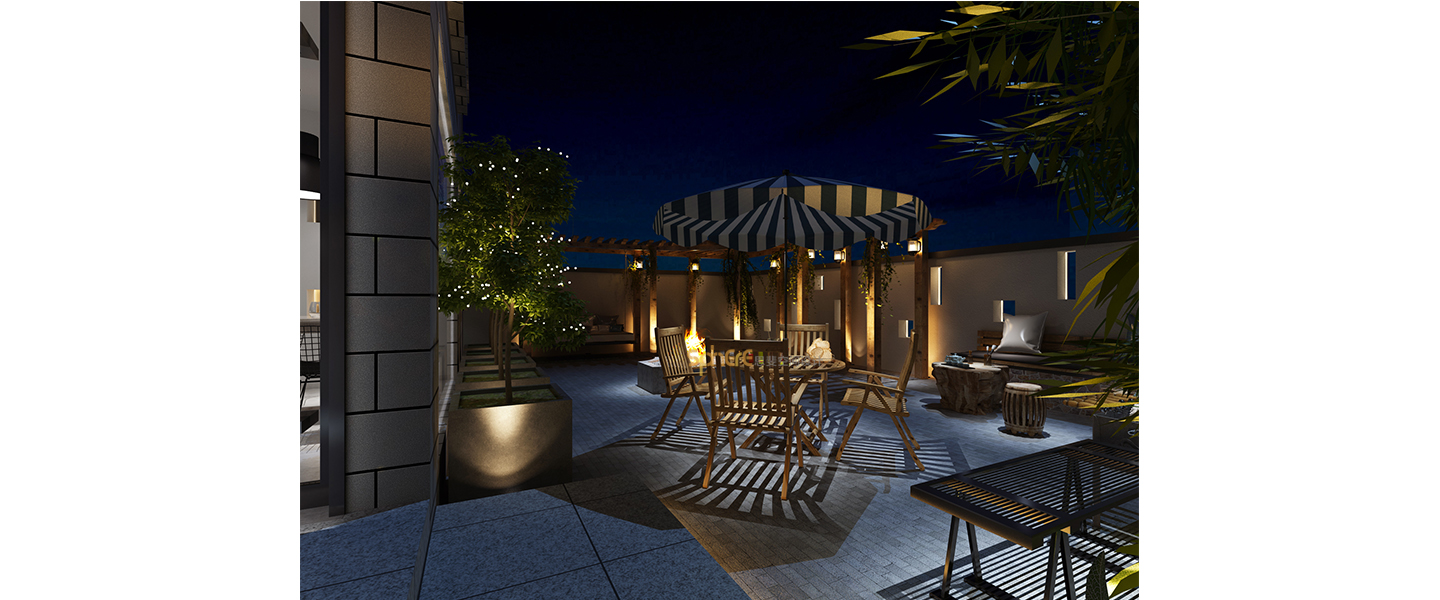Floating in Space W design architecture studio
2014-03-13 01:00
“我们怎么才能以更低的价格给我们的客户更多呢?”是未来的探索建筑师约翰温泽尔和格雷特货车作为W设计建筑工作室开始时,考虑概念设计的这一引人注目的当代,但朴实的建筑。这座建筑坐落在比勒陀利亚东部一条繁忙的郊区公路上,与众多的住宅和小型商业地产交织在一起,它的设计和开发正好符合其不断变化的郊区环境,作为一个适应性强的空间,可以用作房屋、办公室或两者的组合。资源的适应性和优化的理念交织在设计的各个层次,从每一个设计的核心考虑-从建筑的位置和形状到详细的设计和建筑材料的选择-多功能精神交织在一起。
‘How do we give our client more for less?’ is the future-proofing quest architects Johan Wentzel and Grete van As of W Design Architecture Studio embarked upon when considering the conceptual design of this strikingly contemporary, yet unpretentious building. Nestled amongst a mixture of residential and small business properties on a busy sub-urban road in the East of Pretoria, the structure was designed and developed to fit right into its ever-changing suburban context as an adaptable space that can be used as a house, an office or a combination of the two. Theconcept of adaptability and optimization of resources are interwoven into every level of the design and radiatesa spirit of multi-functionality from the very core of each design consideration – from the position and shape of the building on the site up to the detail design and construction material selection.
乍一看,这种做法明显地体现在无限空间的幻象中,这种错觉是通过将相对较小的场地的景观设计延伸到街道边界的边缘,有效地将街道空间和城市环境作为园林景观的一个视觉部分来实现的。这种错觉是由热关闭的混凝土和玻璃结构的建筑物加强的,它轻盈地漂浮在下面的园林上,下面的几根平行的柱子上,并且敏感地包裹在一棵现存的乡间臭木树周围。巧妙的选择草混凝土摊铺机增加了一个额外的绿化机会,将停车场改造为修剪整齐的草坪。
At first glance this approach is evident through the illusion of infinite space that is created by extending the landscaping of the relatively small site right up to the edge of the street boundary, effectively inviting the street space and urban context to become a visual part of the garden landscape. This illusion is reinforced by theraised off-shutter concrete and glass structure of the building that floats lightly above the landscaped garden below on a couple of playfully juxtaposed columns and wrapped sensitively around an existing indigenous stinkwood tree. The clever choice of grass concrete pavers adds an additional greening opportunity by transforming the parking area intoa pristinely manicured lawn.
其结果是一种诱人的气氛,吸引游客到庭院入口,两侧的两个浮动混凝土和玻璃砌块。底层的混凝土核心提供建筑物的基本服务,包括通向一楼的两套隐藏楼梯。
The result is an inviting aura that lures the visitor towards the courtyard entrance, flanked on both sidesby the two floating concrete and glass blocks. The concrete core at ground floor level houses the basic services of the building, including the two hidden sets of staircases that lead up to the first floor level.
一到一楼,就会明白为什么建筑物的主要功能已经从地面上提升了。除了两边的边界墙,实体混凝土结构让路给膨胀的玻璃幕墙,这些玻璃幕墙打开了一个令人惊讶的广阔的视野,畅通无阻。实心混凝土质量在绿叶树之间轻浮的尖锐矛盾,增强了人们对此的体验意识。约翰说:“我们的最终目标是在这栋建筑的上层建立一个‘浮动’空间,通过提供比勒陀利亚东郊的开阔视野,扩大对空间的感知范围。
The moment one reaches the first floor level it becomes clear why the main functions of the building have been raised off the ground. With the exception of the two side boundary walls, the solid concrete structure gives wayto expansive glass curtain walls that open up to a surprisingly wide vista of unobstructed views. The sharp contradiction of solid concrete mass floating lightly between the leafy tree topsheightens one’s experiential awareness to this effect. “Our ultimate aim was to create a 'floating' space on the upper level of the building that would extend the perception of space beyond the boundaries of the property byproviding unobstructed open views of Pretoria's Eastern suburbs,” says Johan.
裸露的关闭式混凝土施工系统的简单性使其能够将整个初级结构-墙壁、地板和屋顶-从单一材料中完全简化成一个简单的形状。无视人们对混凝土是一种“冷”和“固体”建筑材料的普遍看法,建筑师对细节的仔细关注颂扬了混凝土温暖、响应和装饰的一面。在整个建筑中,混凝土屋面板暴露的底部形成了一个图案优美的天花板。用彩色玻璃珠来填补墙上混凝土模板留下的洞,可以让装饰性的彩色光透过墙壁。
The simplicity of the exposed off-shutter concrete construction system made it possible to cast the entire primary structure – walls, floor and roof – as a complete simplified shape from a singular material. Defying the common perception of concrete being a ‘cold’ and ‘solid’ construction material, the architect’s careful attention to detail celebrates the warm, responsive and decorative side of concrete. The exposed underside of the concrete roof slab creates a beautifully patterned ceiling throughout the building. The tongue-in-cheek use of coloured glass beads to fill the holes left by the concrete formwork in the walls allow for decorative coloured light to filter through the walls.
还仔细考虑了建筑物的气候行为。关闭-快门混凝土屋顶悬臂在玻璃墙面段,以提供深刻的保护突出,以防止不想要的直接阳光的渗透。此外,所有窗户都可以滑动,以鼓励通过交叉通风对建筑物进行被动冷却,并配有电动卷帘,以便用户对环境进行最佳控制。
Careful consideration was also given to the climatic behaviour of the building. The off-shutter concrete roof cantilevers over the glazed wall sections to provide deep protective overhangs against the penetration of unwanted direct sunlight. In addition, all the windows slide open to encourage passive cooling of the building through cross ventilation and are equipped with sheermotorized roller blinds to allow for optimal environmental control by the user.
最终,建筑的外部被设计成一个包含多功能室内空间的信封。建筑设计考虑到了多种不同的布局,从而确保了未来的适应性。这些空间的本质就是一张生活在其中的三维空白画布。表面上的“稀薄”邀请居住者参与创作过程,根据他们的具体需要定制灵活的空间。
Ultimately, the exterior of the building is designed as an envelope to contain the multi-functional interior spaces. The architectural design consideration allowed for multiple variations of layouts – thus ensuring future adaptability. The very essence of thespaceresonates that of a three-dimensional blank canvas for living in. The seemingly ‘rawness’ of the finishes invites the occupants to participate in the process of creation by customizingthe flexible spacesaccording to their specific needs.
“多为少”的设计方法导致了一个耐人寻味的建筑反应,在一个不断变化和消费主义驱动的世界里,可持续的建筑和社区被夷为平地。考虑到由于密集化和细分而不断变化的街区结构,建筑应该设计成高度适应性的外壳,以适应居住者不断变化的需求和居住环境,这是非常有道理的。就具体地点而言,土地利用的优化、建筑材料消耗的最低限度办法以及建筑的多功能性质,都是为21世纪创造可持续街区的一种发人深省的选择。
The ‘more for less’ design approach results in an intriguing architectural response towardscreating sustainable buildings and neighbourhoods in a world driven by constant change and consumerism. Taking into considerationthe ever-changing fabric of neighbourhoods as a result of densification and sub-division, it makes perfect sense that buildings should be designed as highly adaptive shells that can accommodate the changing needs of its occupants and the context that it resides in. On a site-specific level, the optimization of land use, the minimalist approach towards construction material consumption and the multifunctional nature of the building presents a thought-provokingalternative towards creating sustainable neighbourhoods for the 21st century.
Architects W design architecture studio
Location Pretoria, South Africa
Architect in Charge Johan Wentzel
 举报
举报
别默默的看了,快登录帮我评论一下吧!:)
注册
登录
更多评论
相关文章
-

描边风设计中,最容易犯的8种问题分析
2018年走过了四分之一,LOGO设计趋势也清晰了LOGO设计
-

描边风设计中,最容易犯的8种问题分析
2018年走过了四分之一,LOGO设计趋势也清晰了LOGO设计
-

描边风设计中,最容易犯的8种问题分析
2018年走过了四分之一,LOGO设计趋势也清晰了LOGO设计
































































